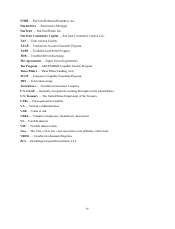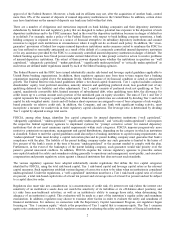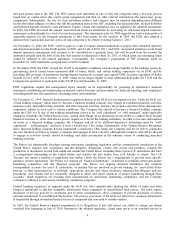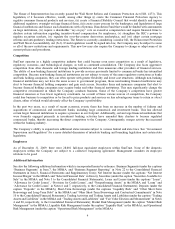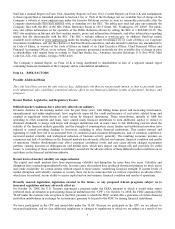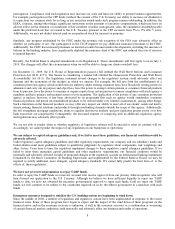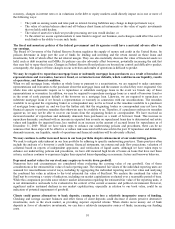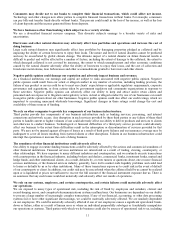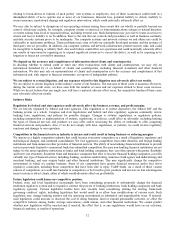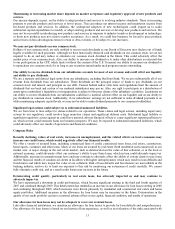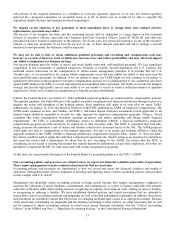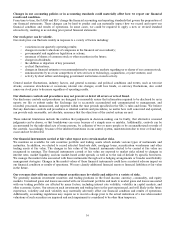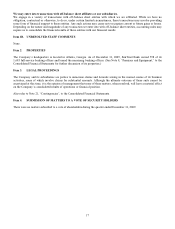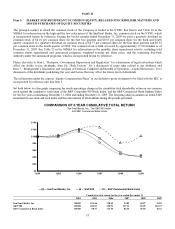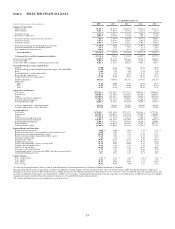SunTrust 2009 Annual Report Download - page 25
Download and view the complete annual report
Please find page 25 of the 2009 SunTrust annual report below. You can navigate through the pages in the report by either clicking on the pages listed below, or by using the keyword search tool below to find specific information within the annual report.Business Risks
We are subject to credit risk.
When we loan money, commit to loan money or enter into a letter of credit or other contract with a counterparty, we incur
credit risk, or the risk of losses if our borrowers do not repay their loans or our counterparties fail to perform according to the
terms of their contracts. A number of our products expose us to credit risk, including loans, leases and lending commitments,
derivatives, trading account assets, insurance arrangements with respect to such products, and assets held for sale. As one of
the nation’s largest lenders, the credit quality of our portfolio can have a significant impact on our earnings. We estimate and
establish reserves for credit risks and credit losses inherent in our credit exposure (including unfunded credit commitments).
This process, which is critical to our financial results and condition, requires difficult, subjective and complex judgments,
including forecasts of economic conditions and how these economic predictions might impair the ability of our borrowers to
repay their loans. As is the case with any such assessments, there is always the chance that we will fail to identify the proper
factors or that we will fail to accurately estimate the impacts of factors that we identify.
Weakness in the economy and in the real estate market, including specific weakness within our geographic footprint,
has adversely affected us and may continue to adversely affect us.
If the strength of the U.S. economy in general and the strength of the local economies in which we conduct operations do not
improve, or continue to decline, this could result in, among other things, a deterioration of credit quality or a reduced demand
for credit, including a resultant effect on our loan portfolio and ALLL. A significant portion of our residential mortgages and
commercial real estate loan portfolios are composed of borrowers in the Southeastern and Mid-Atlantic regions of the United
States, in which certain markets have been particularly adversely affected by declines in real estate value, declines in home
sale volumes, and declines in new home building. These factors could result in higher delinquencies and greater charge-offs
in future periods, which would materially adversely affect our financial condition and results of operations.
Weakness in the real estate market, including the secondary residential mortgage loan markets, has adversely
affected us and may continue to adversely affect us.
Significant ongoing disruptions in the secondary market for residential mortgage loans have limited the market for and
liquidity of many mortgage loans. The effects of ongoing mortgage market challenges, combined with the ongoing correction
in residential real estate market prices and reduced levels of home sales, could result in further price reductions in single
family home values, adversely affecting the value of collateral securing mortgage loans that we hold, mortgage loan
originations and profits on sales of mortgage loans. Declining real estate prices have caused cyclically higher delinquencies
and losses on certain mortgage loans, particularly Alt-A mortgages and home equity lines of credit and mortgage loans
sourced from brokers that are outside our branch bank network. These conditions have resulted in losses, write downs and
impairment charges in our mortgage and other lines of business. Continued declines in real estate values, home sales
volumes, financial stress on borrowers as a result of job losses, interest rate resets on ARMs or other factors could have
further adverse effects on borrowers that could result in higher delinquencies and greater charge-offs in future periods, which
adversely affect our financial condition or results of operations. Additionally, counterparties to insurance arrangements used
to mitigate risk associated with increased foreclosures in the real estate market are stressed by weaknesses in the real estate
market and a commensurate increase in the number of claims. Additionally, decreases in real estate values might adversely
affect the creditworthiness of state and local governments, and this might result in decreased profitability or credit losses
from loans made to such governments. A decline in home values or overall economic weakness could also have an adverse
impact upon the value of real estate or other assets which we own upon foreclosing a loan and our ability to realize value on
such assets.
As a financial services company, adverse changes in general business or economic conditions could have a material
adverse effect on our financial condition and results of operations.
The continuing weakness or further weakening in business and economic conditions generally or specifically in the principal
markets in which we do business could have one or more of the following adverse impacts on our business:
• A decrease in the demand for loans and other products and services offered by us;
• A decrease in the value of our LHFS or other assets;
• A loss of clients and/or reduced earnings could trigger an impairment of certain intangible assets, such as goodwill;
• An increase in the number of clients and counterparties who become delinquent, file for protection under
bankruptcy laws or default on their loans or other obligations to us. An increase in the number of delinquencies,
bankruptcies or defaults could result in a higher level of nonperforming assets, net charge-offs, provision for credit
losses, and valuation adjustments on LHFS.
Changes in market interest rates or capital markets could adversely affect our revenue and expense, the value of
assets and obligations, and the availability and cost of capital or liquidity.
Given our business mix, and the fact that most of the assets and liabilities are financial in nature, we tend to be sensitive to
market interest rate movements and the performance of the financial markets. In addition to the impact of the general
9



